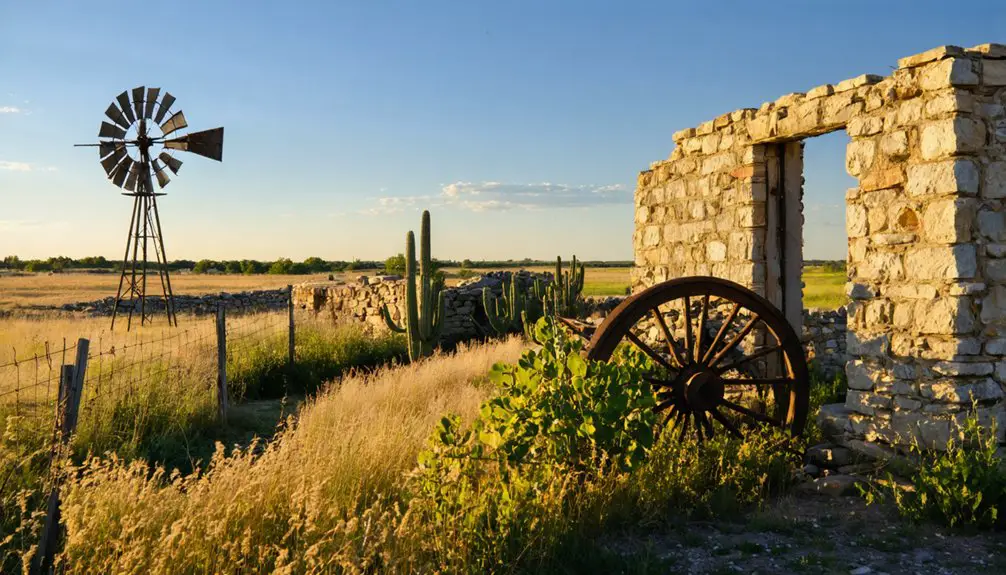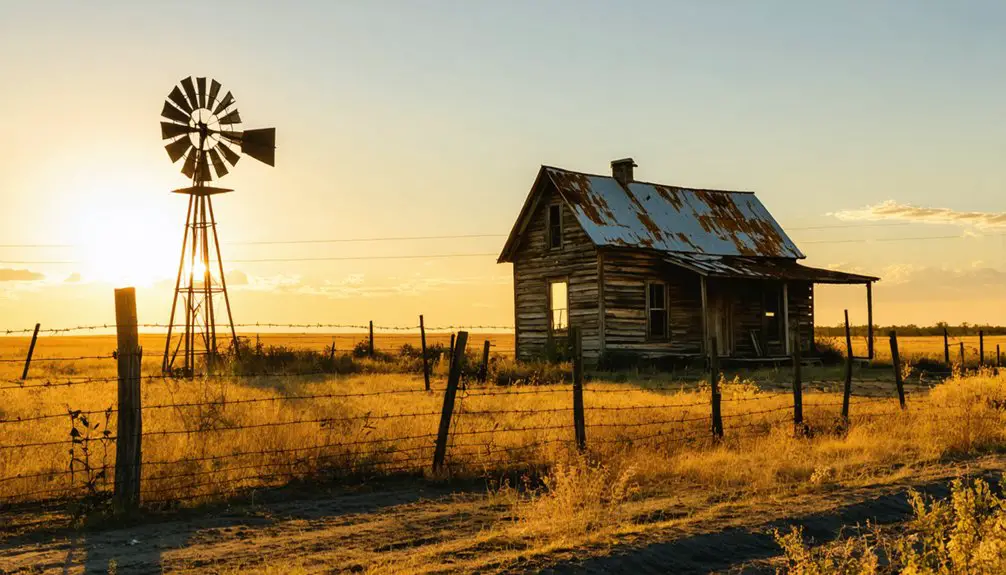You’ll find Cincinnati’s ghost town remains off FM 3478 in Walker County, Texas. Founded in 1838 by James C. De Witt, this Trinity River port town once bustled with 600 residents and thriving river commerce. Disease struck in the 1850s, forcing residents to flee, and the railroad’s 1872 bypass sealed the town’s fate. Today, only cemetery markers and buried foundations hint at Cincinnati’s existence. The town’s buried secrets tell a fascinating tale of boom and bust.
Key Takeaways
- Cincinnati, Texas was founded in 1838 by James C. De Witt as a thriving river port on the Trinity River.
- The town reached its peak with 600 residents and served as a major shipping point for cotton, sugar, and supplies.
- A devastating yellow fever outbreak forced residents to flee, causing businesses to fail and the community to collapse.
- The railroad’s arrival in 1872 bypassed Cincinnati by 15 miles, further accelerating its decline into a ghost town.
- Archaeological findings and LiDAR technology reveal the town’s layout, with cemetery sites serving as primary evidence of the vanished community.
The Rise of a Trinity River Port Town
A strategic vision led James C. De Witt to establish Cincinnati in 1838 at the furthest navigable point on the Trinity River.
You’ll find that this location wasn’t chosen by chance – it’s where river commerce thrived as steamboats connected inland Texas with Gulf Coast markets.
The town’s port infrastructure quickly expanded to meet the demands of a bustling trade network.
Growing trade demands transformed the small riverside port into a dynamic hub of commercial infrastructure and activity.
You’d have seen packet boats laden with cotton, sugar, and hides heading downstream, while supplies and dry goods made their way up to enthusiastic merchants.
The Hunter Hotel rose as the first major building, followed by a vibrant mix of businesses including blacksmith shops, saloons, and a post office.
The Scioto Belle steamboat became a familiar sight at the port by 1844, marking the height of river transportation.
The town’s prosperity showed in its well-built homes featuring spacious porches and elegant columns.
The community grew to include nearly twenty veterans of the Battle of San Jacinto among its residents.
Life Along the River Bluffs
Perched atop the Trinity River bluffs, Cincinnati’s 600 residents carved out a bustling life amid dense East Texas hardwoods and fertile slopes.
You’d find the community’s heartbeat along streets like Dit, Brookfield, and Milan, where wooden buildings housed merchants servicing river commerce and local farmers alike.
Life revolved around the river’s rhythm, with townsfolk working the rich soil for corn and cotton, then shipping their harvest downstream to enthusiastic markets. Much like the town of Red River Station, Cincinnati relied heavily on its strategic location along waterways for trade and transportation.
You’d see the town’s community resilience in action at churches, schools, and local businesses, where neighbors gathered to share news and support one another. The nearby cemetery remains provide a lasting testament to the lives of early settlers.
Daily routines followed the contours of the land, as residents navigated the ridges and slopes that shaped their frontier town, making the most of nearby creeks and the mighty Trinity for their water needs.
Disease and Devastation Strike
Tragedy struck Cincinnati when a devastating plague swept through the bustling river town, forcing most of its 600 residents to flee their homes.
You’d have witnessed the epidemic consequences unfold rapidly as the mysterious disease crippled daily life, commerce, and the town’s once-promising future.
The dramatic population decline created a domino effect – fewer workers meant failing businesses, while the exodus of residents left behind a weakened community that couldn’t attract new settlers.
A shrinking population triggered catastrophic business failures, creating a ghost town that newcomers avoided like the plague itself.
Those who survived sought safer places to rebuild their lives, many relocating to the newly established town of Riverside after a railroad bypassed Cincinnati.
The town was ultimately absorbed by Irving as its population continued to dwindle throughout the early twentieth century.
Like a database connection failure, the town’s vital systems and networks gradually shut down as more residents departed, leaving the community unable to function.
The Railroad’s Fatal Impact
While Cincinnati had once thrived as a bustling riverport on the Trinity River, the arrival of the railroad in 1872 sealed its fate. The railroad rerouting bypassed Cincinnati by 15 miles, favoring Riverside instead.
You’d have watched helplessly as businesses, trade, and people drifted away to railroad-connected towns. The town’s population had dwindled to only 35 residents by the early 1880s.
Like other towns facing armed mine guards, economic stagnation hit hard and fast. The town’s reliance on river transport became obsolete as railroads dominated East Texas commerce.
By 1892, you couldn’t even get mail in Cincinnati anymore – the post office closed, marking the town’s death knell. Workers and settlers sought opportunities elsewhere, leaving infrastructure to crumble.
Today, you’ll find little evidence of Cincinnati’s existence beyond a cemetery and historical marker, stark reminders of how a single railroad decision could doom an entire community.
Archaeological Discoveries and Modern Mapping
Modern archaeological techniques have breathed new life into Cincinnati’s forgotten streets and structures. Using cutting-edge LiDAR technology, you’ll discover how researchers have mapped the ghost town‘s layout beneath years of vegetation growth. Research and conservation plays a vital role in preserving these irreplaceable heritage sites.
Advanced technology reveals Cincinnati’s hidden past, as LiDAR mapping uncovers a ghost town’s secrets beneath dense vegetation.
This powerful tool reveals hidden features like buried grave markers and street alignments that you can’t spot with the naked eye. Similar to how the French settlers established the town with 29 families, these mapping efforts help reconstruct the original community layout.
When combined with historical maps from the 1800s, artifact recovery efforts have painted a vivid picture of life in Cincinnati.
Here’s what’s been unearthed:
- Period-specific coins dating to the 1820s-1830s
- Building foundations and fireplace remains
- Ceramic shards, metal nails, and glass fragments
These findings suggest Cincinnati once supported a population of 600 people, with clear evidence of streets like Dit, Brookfield, and Milan still visible through modern mapping techniques.
What Remains: Cemeteries and Markers
You’ll find at least three distinct cemetery sites scattered around Cincinnati’s former townscape, though their exact boundaries remain unclear due to the non-standard layout of this early Texas settlement.
The burial grounds include what appears to be a segregated section and possibly a separate yellow fever victims’ cemetery, identifiable through LiDAR mapping and ground surveys.
While most physical markers have deteriorated or vanished over time, the cemetery sites stand as essential historical records, marked by ancient tree lines and faint boundary traces that modern technology helps reveal.
Cemetery Locations Today
Through advanced LiDAR imaging, researchers have identified three distinct cemetery sites within Cincinnati’s ghost town boundaries.
Modern cemetery mapping reveals these burial grounds weren’t laid out in orderly patterns, reflecting the rural burial customs of the time. One site’s likely the Yellow Fever Cemetery, though exact identification remains uncertain.
If you’re planning to visit these historic sites, you’ll want to note:
- Natural boundaries like tree lines and fences mark cemetery perimeters
- Most markers are simple wooden crosses in dirt mounds, not elaborate tombstones
- Dense vegetation and unstable terrain make physical access challenging
Today, these cemeteries serve as the primary physical evidence of Cincinnati’s vanished community, with some areas suggesting segregated burial grounds, including what may have been a separate Black Cemetery.
Historical Marker Details
Standing as a solemn tribute to Cincinnati’s past, the Texas Centennial marker #8436 commemorates this once-thriving Trinity River settlement.
You’ll find this gray granite monument off FM 3478 in Walker County, though it’s now situated on private property with restricted access.
The marker’s historical significance lies in its preservation of Cincinnati’s brief but compelling story – from its 1838 founding by James C. De Witt as an essential shipping point to its tragic abandonment during the devastating yellow fever outbreak of 1853.
While the marker stands as a representation of the community’s resilience, it’s one of the few remaining physical connections to this vanished town, along with scattered cemetery plots and the collapsed remains of a Texas Rangers well constructed around 1940.
Legacy of an Early Texas Settlement

Although Cincinnati, Texas now exists only in historical records and a few scattered remains, its legacy as an early Texas settlement offers valuable insights into the state’s developmental patterns.
The town’s story exemplifies settlement resilience as it adapted to challenges like disease outbreaks and shifting trade routes, while also highlighting the economic changes that shaped Texas communities.
You’ll find that Cincinnati’s evolution mirrors many early Texas settlements:
- Started as a thriving river port with 600 residents and organized streets
- Faced devastating setbacks from plagues and railroad bypasses
- Transformed from bustling trade hub to ghost town as economic forces shifted
Today, while you won’t find much more than cemetery remains and a historical marker, Cincinnati’s story continues to teach us about the vulnerability and adaptability of frontier communities.
Preserving Cincinnati’s Historical Footprint
The preservation of Cincinnati’s historical footprint remains a significant undertaking that builds upon its frontier legacy.
You’ll find preservation techniques focused on maintaining authentic 19th-century structures, from wood-frame homes to period-specific commercial buildings that tell the story of Texas frontier life.
Community engagement drives these efforts, with local historical societies partnering alongside preservation experts to conduct architectural surveys and implement restoration plans.
Through systematic documentation and hands-on volunteer work, you’re witnessing a collaborative effort to save Cincinnati’s remaining structures while collecting oral histories from descendants of former residents.
You can explore the town’s heritage through educational programs and guided tours, which showcase the restored sites and bring the settlement’s unique history to life while supporting heritage tourism initiatives.
Frequently Asked Questions
What Native American Tribes Originally Inhabited the Cincinnati, Texas Area?
You’ll find the area’s cultural heritage included Caddoan peoples, particularly the Hasinai Confederacy. The tribal history also shows Akokisa, Atakapa, and later Shawnee migrations through the region.
How Many Steamboats Typically Docked at Cincinnati’s Port Each Month?
Like clockwork, you’d see dozens of steamboats docking monthly at Cincinnati’s bustling port during peak periods, with port activity records showing multiple vessels could dock simultaneously along its 2.5-mile riverfront.
What Were the Main Crops and Agricultural Products of Cincinnati?
You’d find cotton production dominated Cincinnati’s farming scene, alongside corn and wheat cultivation. Local farmers also maintained small fruit harvesting operations and vegetable gardens for their community’s needs.
Did Any Famous Historical Figures Ever Visit or Live in Cincinnati?
You won’t find any famous visitors in Cincinnati’s history books. While the town had regional historical significance as a Trinity River port, there’s no evidence of nationally recognized figures ever staying there.
What Happened to the Families Who Stayed After the Plague?
You’ll find those who stayed faced brutal plague impact – farming for survival, battling isolation, and dealing with broken community ties. Many families struggled with chronic health issues and dwindling resources.
References
- https://en.wikipedia.org/wiki/List_of_ghost_towns_in_Texas
- https://www.youtube.com/watch?v=SuwG1SmCnlI
- https://www.youtube.com/watch?v=d_ZKPq4Tk8g
- https://urbexunderground.com/ghost-towns-in-texas/
- https://www.texasescapes.com/TOWNS/Texas-Ghost-Towns-2-Central-Texas.htm
- https://www.texasescapes.com/TOWNS/Texas_ghost_towns.htm
- https://www.simplytexan.com/truly-texan/abandoned-ghost-towns-in-texas/
- https://en.wikipedia.org/wiki/Lists_of_ghost_towns_in_the_United_States
- https://ourwovenjourney.com/texas-ghost-towns/
- https://mansfieldphoto.com/journal/7-texas-ghost-towns/



